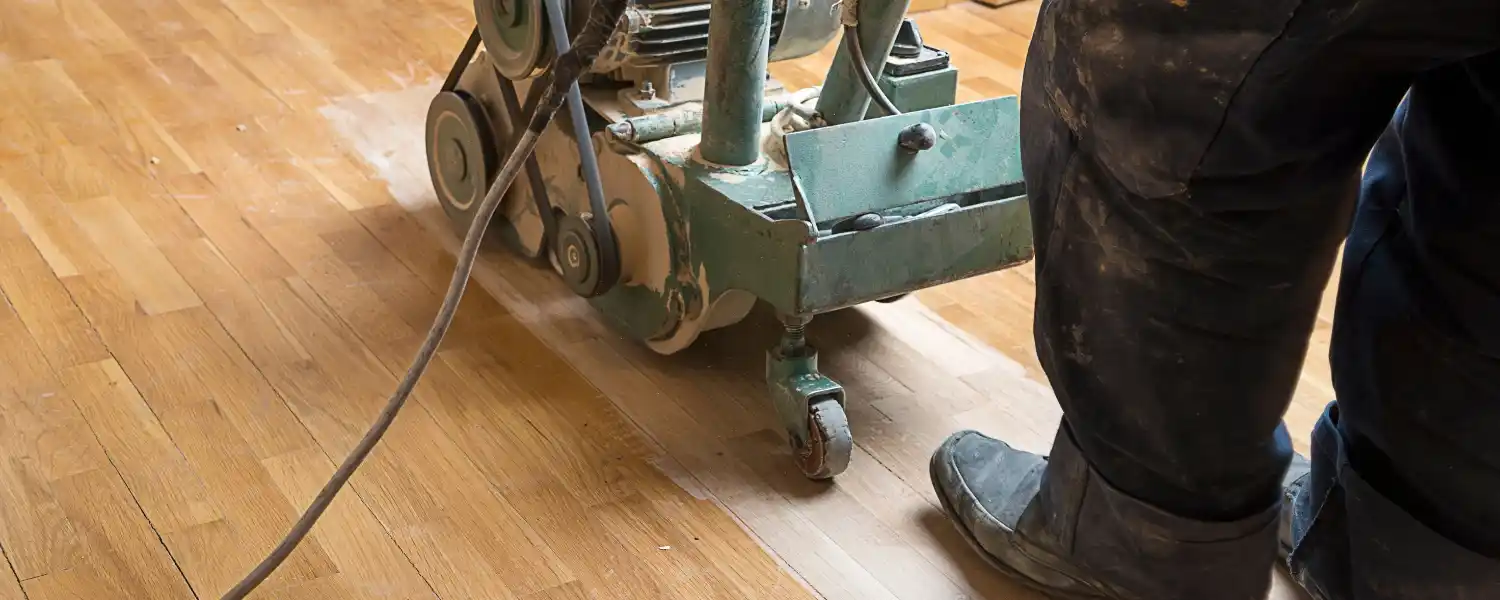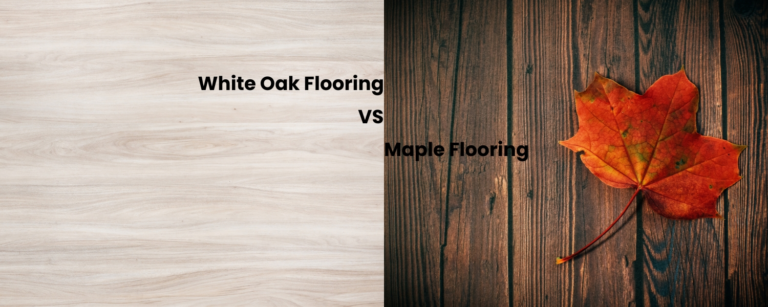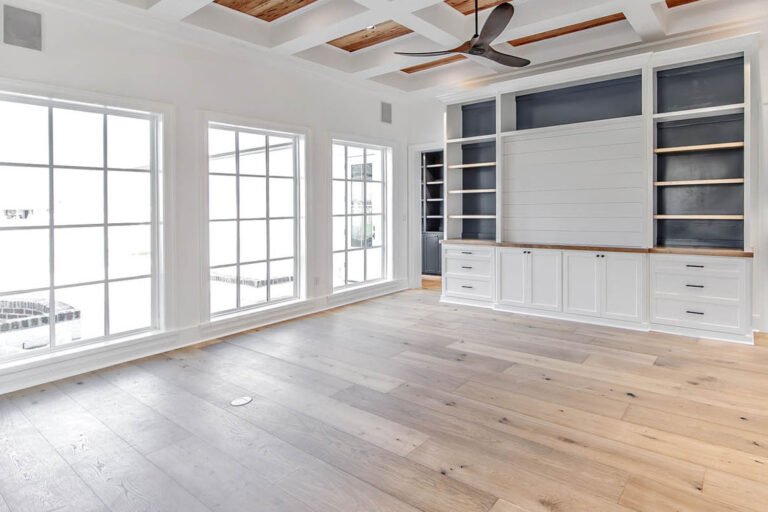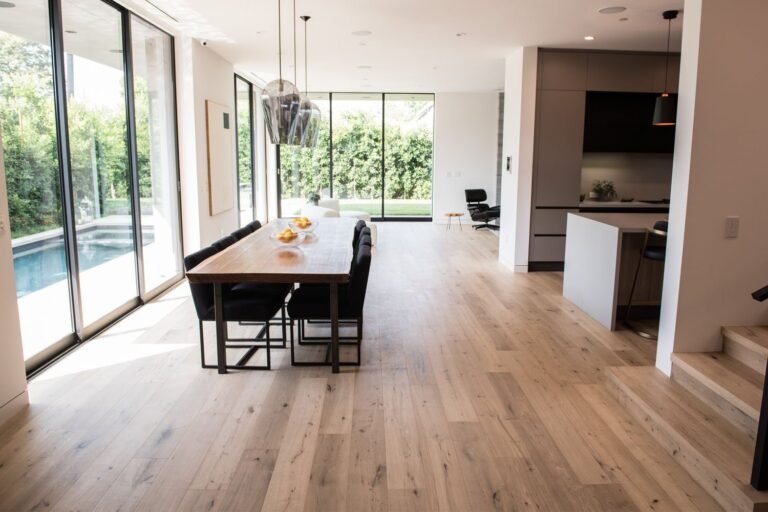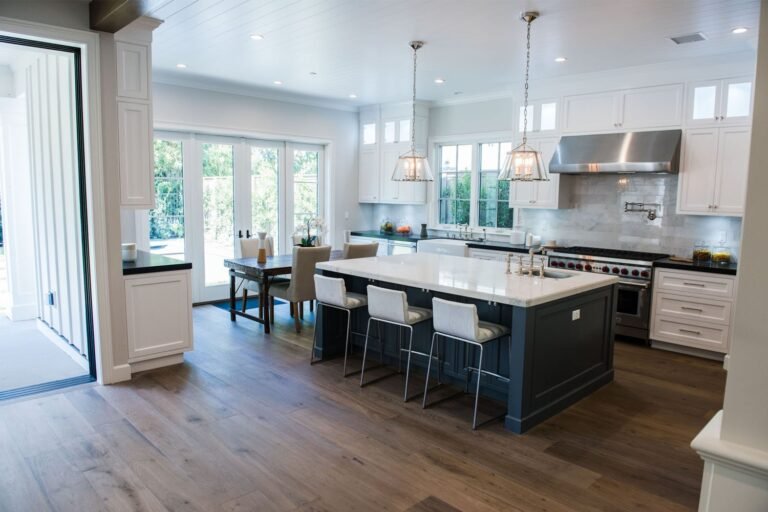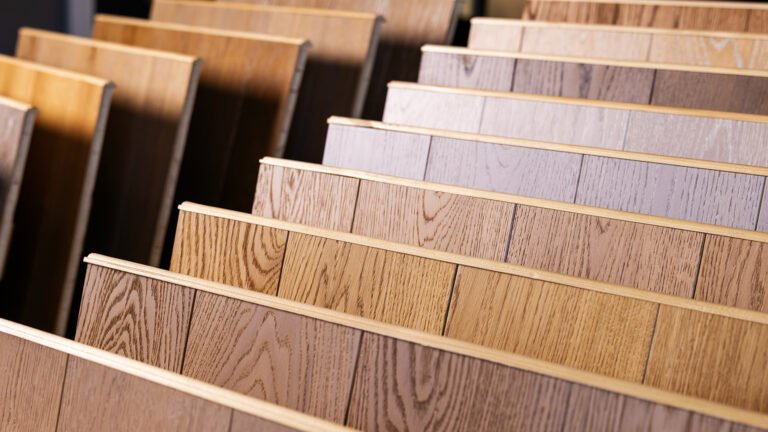Can Engineered Hardwood be Refinished?
Have you noticed that the beauty of your engineered hardwood flooring isn’t what it used to be? Are you wondering, “Can engineered hardwood be refinished?” Like many homeowners, you might hope to restore that original shine and allure. In this guide, we will explore whether you can refinish engineered hardwood floors, how to do it, and what you need to consider to help make your decision clearer and simpler.
What is Engineered Hardwood Flooring?
Engineered hardwood flooring is a versatile and durable choice for modern homes. It is constructed from multiple layers of wood veneers, each stacked and bonded under intense heat and pressure. Unlike traditional solid hardwood, engineered hardwood combines these layers to enhance stability, making it less susceptible to the effects of moisture and temperature changes. This structure also allows the refinishing of engineered hardwood floors, breathing new life into the flooring.
Learn more about engineered hardwood flooring in our comprehensive blog, “What Is Engineered Hardwood Flooring?“
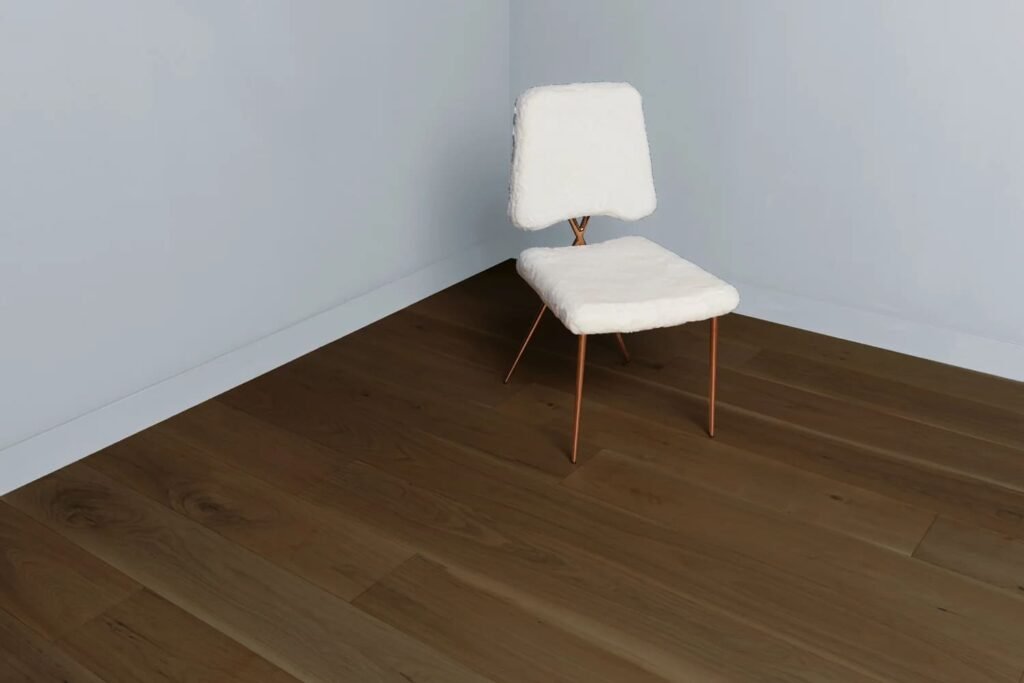
Signs Your Engineered Hardwood Flooring Needs Refinishing
It’s essential to know when your engineered hardwood flooring requires refinishing. Here are some key indicators:
Surface Scratches and Wear
Surface scratches and wear are common signs that your floors might need attention. Regular foot traffic and furniture movement can leave visible marks and abrasions, signaling it’s time for a refinishing touch.
Fading or Discoloration
When the protective top layer wears away, noticeable fading or discoloration can occur. A refinishing job can help restore your floors’ vibrant color and consistency.
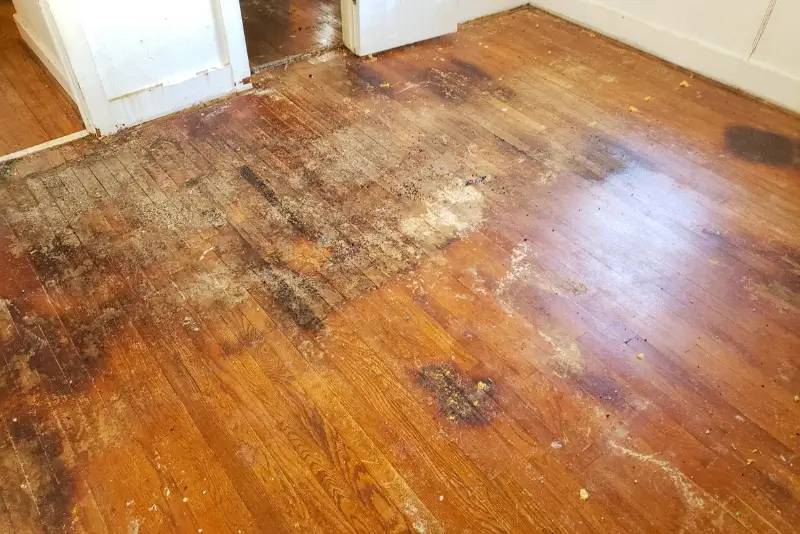
Rough or Uneven Texture
A rough or uneven texture often indicates significant wear and tear, which refinishing can smooth out. This process restores a sleek and comfortable feel underfoot.
Loss of Sheen
Engineered hardwood flooring is typically coated with a protective finish that adds a glossy sheen to the surface. If your floors have lost their glossy sheen, this is a clear sign that the protective finish has worn off and needs reapplication during refinishing.
Age of the Flooring
Consider the age of your engineered hardwood flooring. Prolonged use and environmental exposure can naturally degrade its appearance and performance, making refinishing an excellent option to maintain its beauty and durability.
The Refinishing Process of Engineered Hardwood Floors
Refinishing engineered hardwood floors can significantly enhance your space, making it look as good as new. Here’s a detailed step-by-step guide to the refinishing process:
Step-by-Step Explanation of the Refinishing Process
Preparation
Begin by clearing the area of furniture and covering all nearby surfaces to protect them from dust. Inspect the floor for protruding nails or loose boards and secure them as needed.
Sanding
The next step is sanding. Using a floor sander, sand the surface to remove the old finish and smooth any imperfections. This step is crucial for a uniform texture.
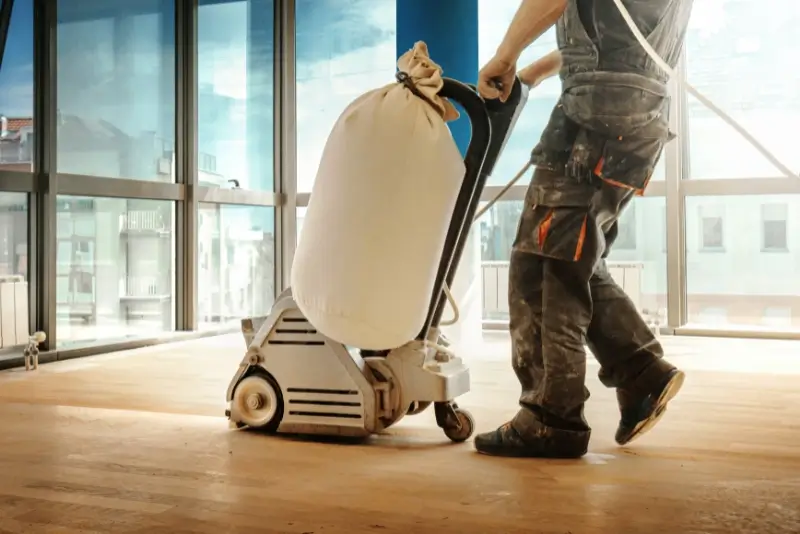
Cleaning
Once the sanding is complete, thoroughly clean the flooring to remove dust and debris. Use a vacuum cleaner and tack cloth to ensure the surface is free of particles that could interfere with the new finish’s application.
Staining (Optional)
If desired, apply a new stain to change the color of your floors. Select a stain that matches your home’s aesthetic and use it according to the manufacturer’s directions.
Applying Finish
After surface preparation, the next step is to apply the finish. Use a durable finish like polyurethane. Use a brush or applicator pad to apply thin, even coats, following the wood grain. The finish protects the floor and restores its shine.
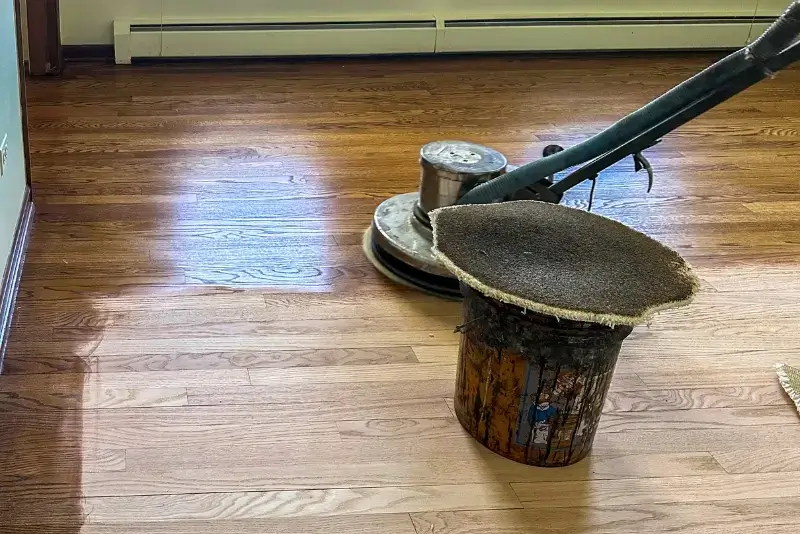
Drying and Curing
Allow the finish to dry completely between coats, usually several hours to overnight. After the final coat, let the floor cure for the recommended period before resuming foot traffic.
Final Inspection
Once the refinishing process is complete, perform a final inspection to ensure the flooring meets your expectations. Inspect the floor for any uneven areas or missed spots. Perform necessary touch-ups before moving furniture back into the room.
Maintenance
Follow a regular cleaning and maintenance routine to preserve the beauty of your refinished flooring. Sweep or vacuum regularly to remove dirt and debris, and use a damp mop with a mild cleaner as needed. Avoid harsh chemicals and excessive moisture, as these can damage the finish over time. Place furniture pads under heavy items to prevent scratches.
DIY vs. Professional Refinishing: What You Need to Know
| Parameter | DIY Refinishing | Professional Refinishing |
| Cost | Generally lower cost, but requires purchasing or renting equipment | Higher initial cost due to labor and professional expertise |
| Time Required | Longer time required | Faster than DIY refinishing |
| Skill Level Required | Suitable for those with basic DIY skills | Professional expertise and specialized equipment required |
| Quality of Finish | Quality of finish may vary based on DIYer’s skill and experience | Consistently high-quality finish with professional services |
| Warranty | No warranty | Often includes warranty |
Pros and Cons of Refinishing Engineered Hardwood
Advantages of Refinishing
Refinishing engineered hardwood flooring offers several benefits. Some of them are:
- Restoration: Restores the flooring’s appearance and durability, removing scratches and stains.
- Cost-Effective: Refinishing is more affordable than replacing.
- Customization: Allows for color and sheen customization to suit personal style.
- Property Value: Enhances the appeal and value of the property.
Potential Drawbacks or Limitations
While refinishing can offer numerous benefits, there are also some potential drawbacks or limitations to consider:
- Disruption: Requires furniture removal and may cause temporary inconvenience.
- Professional Expertise: Achieving quality results may require professional skills.
- Risk of Damage: Improper techniques can lead to damage or need for replacement.
- Limited Refinishing Cycles: Engineered hardwood has limited refinishing cycles due to its veneer thickness.
Critical Factors Before Refinishing Engineered Hardwood Floors
Assessing Your Floors’ Suitability for Refinishing
Before refinishing your engineered hardwood floors:
- Evaluate their condition.
- Look for signs of wear, like scratches, stains, or fading.
- Check for structural issues such as warping or loose boards.
Ensure the hardwood veneer layer can withstand sanding without damage.
Impact on Durability and Longevity
Refinishing can boost your floors’ durability and lifespan. A fresh finish coat enhances resistance to scratches, moisture, and damage. Use high-quality products and techniques for lasting results. Regular maintenance, like gentle cleaning, extends the refinished floors’ life.
Cost Considerations
Refinishing is a cost-effective option but plan your budget wisely. Consider the size of the area and the condition of the floors. On average, expect to spend $3–$6 per square foot for professional refinishing.
Maintaining Your Engineered Hardwood Floors Post Refinishing
Care and Maintenance Tips
After refinishing your engineered hardwood floors, proper care and maintenance are essential to preserve their beauty and durability. Here are some tips to keep your floors looking their best:
- Regular Cleaning: Sweep or vacuum floors to remove dirt and debris. For stains, use a damp mop with a mild cleaner.
- Avoid Excess Moisture: Clean up spills promptly. Use mats or rugs in high-traffic areas to trap moisture and protect floors.
- Protect from Furniture: Place felt pads or glides under heavy furniture. Avoid dragging furniture to prevent scratches.
- Minimize Sun Exposure: Use curtains or blinds to block UV rays and prevent fading or discoloration.
- Exercise Caution with Pets: Trim pet nails to prevent scratches. Use mats under pet dishes to catch spills and protect against moisture damage.
Learn to clean engineered hardwood floors in detail in our other blog, “How To Clean Engineered Hardwood Floors?“
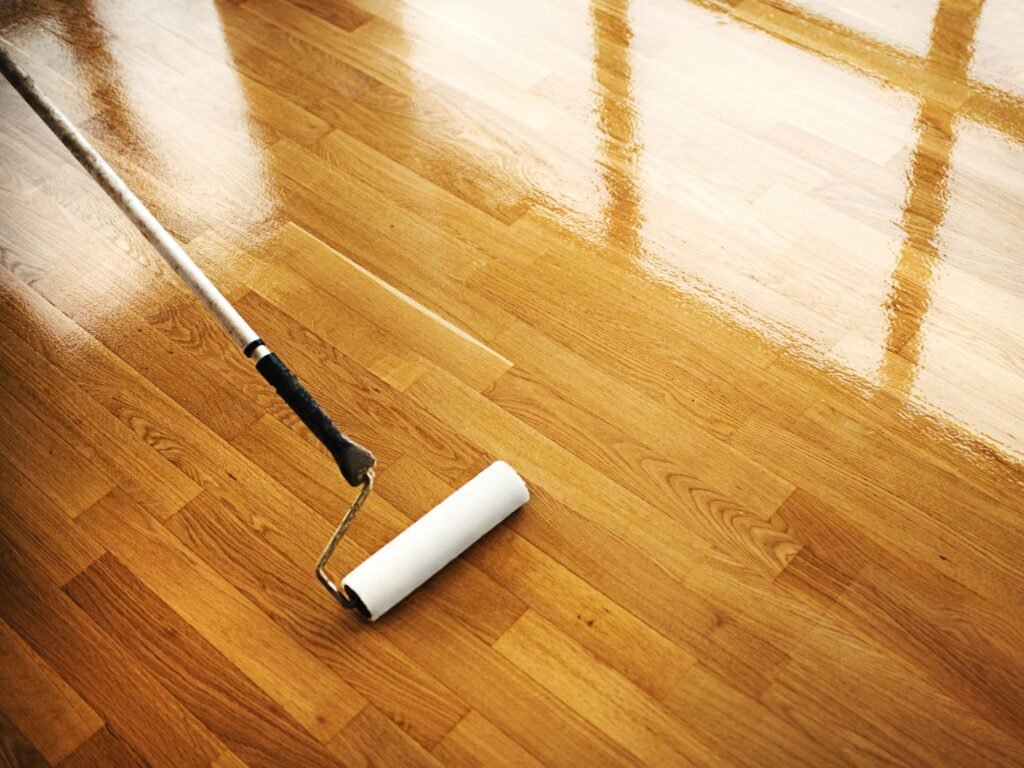
Protecting Your Investment: Long-Term Floor Care
Proper care of your engineered hardwood floors helps protect your investment and prolong their lifespan. Here are some long-term floor care strategies to consider:
- Schedule Regular Maintenance: Create a maintenance routine for your floors. This routine includes cleaning, buffing, and recoating to refresh the finish and protect the surface.
- Monitor Humidity Levels: Monitor humidity. Use a humidifier in dry climates and a dehumidifier in humid areas to maintain stable indoor humidity levels and prevent floor damage.
- Inspect for Damage: Regularly check for signs of wear like scratches, dents, or loose boards. Address issues promptly to maintain the floor’s quality.
- Professional Maintenance: Consider hiring experts for inspections and maintenance. They offer services like deep cleaning, sanding, and refinishing to restore your floors’ appearance and longevity.
Upgrade Your Space with Refinished Engineered Hardwood Flooring
Refinishing your engineered hardwood floors can dramatically improve their appearance and lifespan. Identify the right time for refinishing by looking for signs of wear and considering the age of your floors. Refinishing involves many steps, such as sanding, cleaning, and applying finish. Whether you choose DIY or professional refinishing, you can achieve a fresh and inviting look.
For all your flooring needs, remember Villagio Wood Floors. We provide expertise and high-quality options for every project. With our expertise in engineered hardwood flooring, we provide valuable insights and recommendations to help you achieve the best results for your projects. Let us help you transform spaces with timeless elegance and durability.
Can Engineered Hardwood be Refinished? – FAQs
Does Refinishing Affect the Lifespan of Engineered Hardwood Floors?
Yes! Refinishing can positively impact the lifespan of engineered hardwood floors. By removing surface imperfections and applying a fresh protective finish, refinishing enhances durability and resistance to wear.
Can you refinish engineered hardwood floors with a veneer thinner than 2mm?
Refinishing floors with a veneer thinner than 2mm is risky, as it may cause damage during sanding.
How does the cost of refinishing engineered hardwood compare to replacement?
In general, refinishing engineered hardwood floors is more cost-effective than replacement. While the exact cost can vary depending on factors such as the size of the area, condition of the flooring, and desired finish, refinishing typically involves lower labor and material costs than installing new flooring.
Can refinishing engineered hardwood floors remove deep scratches and stains?
Yes! Refinishing engineered hardwood floors can remove deep scratches and stains. It eliminates imperfections by sanding the surface and applying a fresh finish. However, the extent of removal depends on the severity of the scratches and stains.

